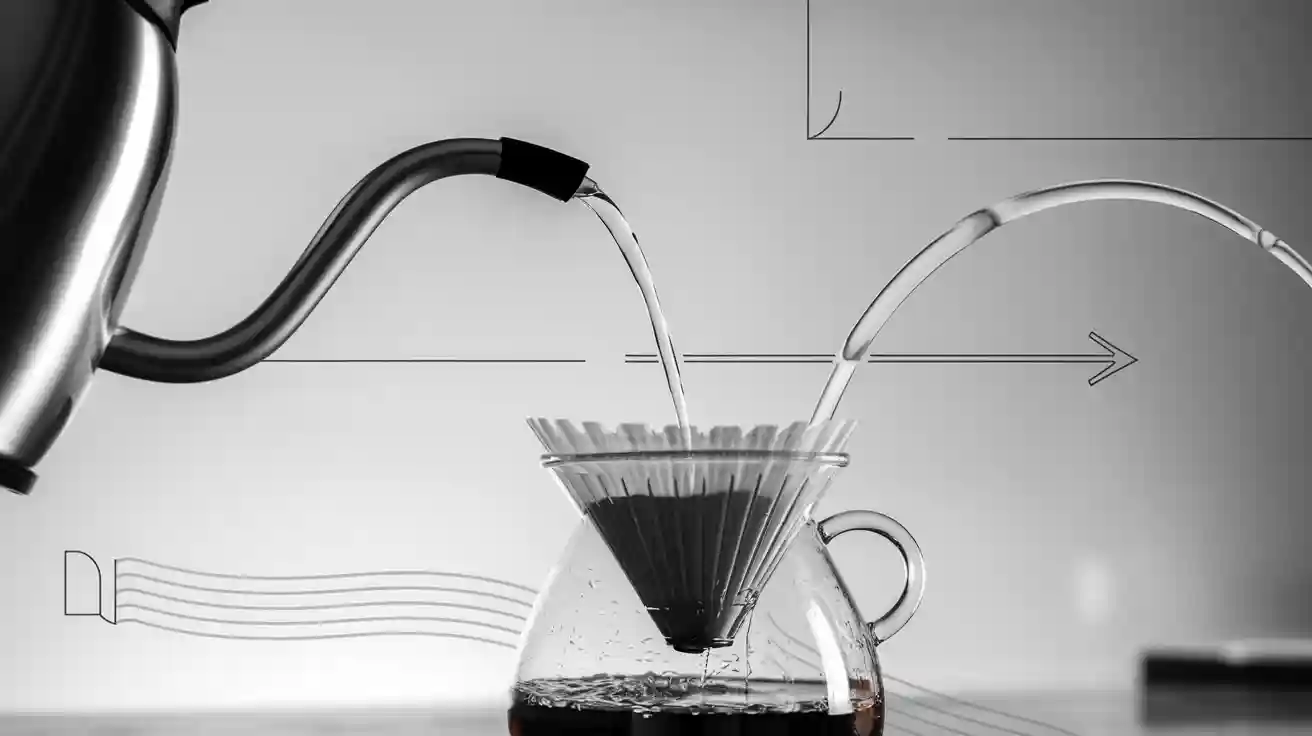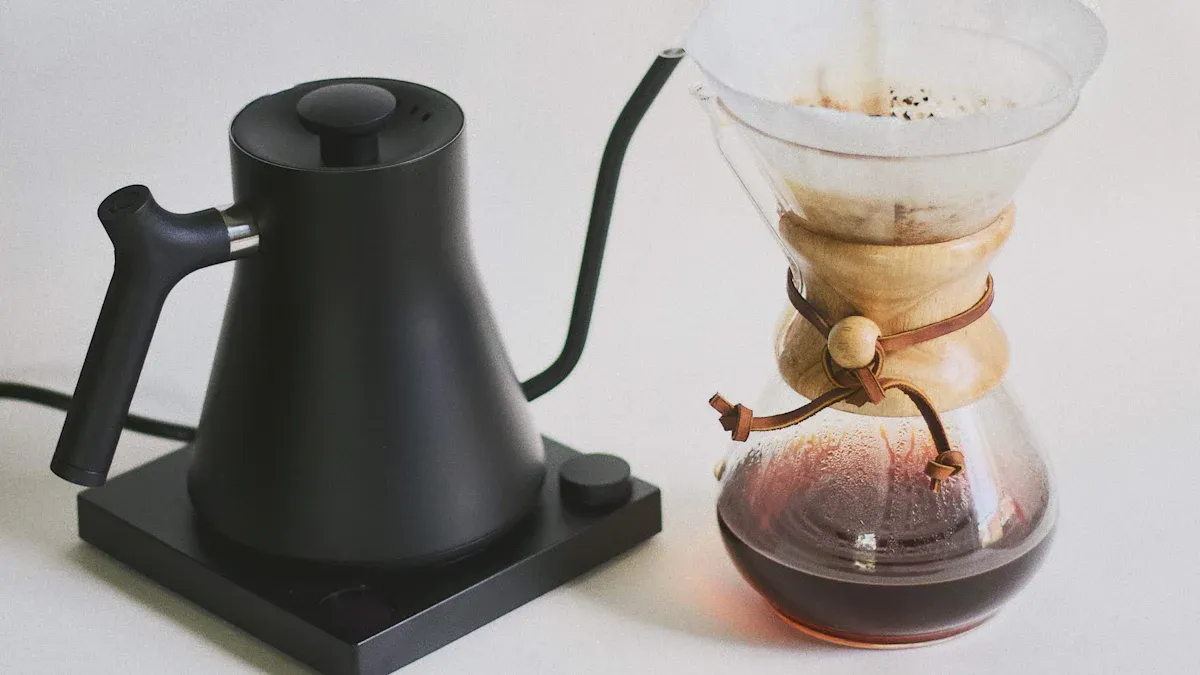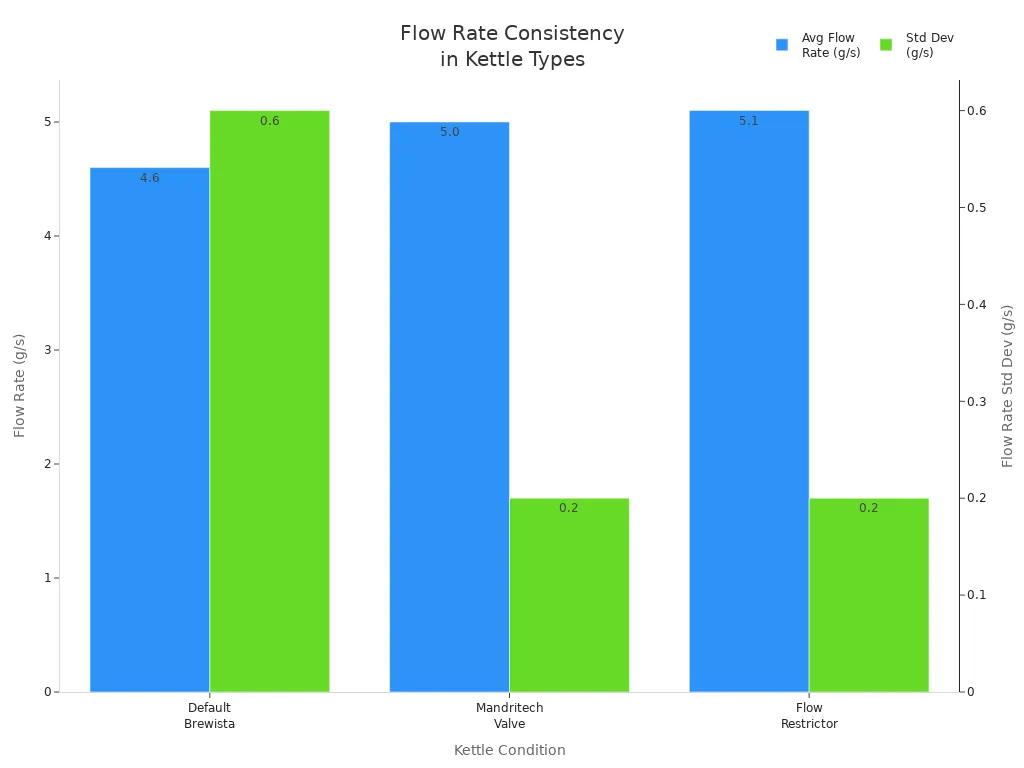
When you use an electric kettle gooseneck, you gain precise control over water flow.
- The long, narrow spout lets you pour slowly and evenly, unlike traditional kettles.
- Precision pouring ensures every coffee ground gets equal attention, which boosts flavor and consistency.
Many electric gooseneck kettle models also offer temperature control for better results.
Electric Kettle Gooseneck Design Features

Spout Shape and Length
When you choose an electric kettle gooseneck, the spout shape and length play a big role in how water flows. Smoother and longer gooseneck spouts help you pour a steady, vertical stream. This stream stays together longer before breaking into droplets, which means you get better control and less splashing. If the spout is rough or short, the water stream can break up quickly and become harder to manage. High-quality gooseneck kettle designs also reduce the “teapot effect,” where water clings to the spout and bends away from your target. You want a spout that keeps the stream straight and easy to direct, especially when you brew coffee.
Handle Ergonomics
Handle ergonomics matter for comfort and accuracy. You will notice that many gooseneck kettle models have handles shaped for easy gripping. These handles help you control the pour and keep your hand steady. For example, the Bodum Melior Gooseneck Kettle and KitchenAid Precision Gooseneck both use comfortable grips that make pouring easier and reduce fatigue. Some kettles, like the Hario V60 Buono, have heat-resistant handles set at an angle for smooth pouring. When you use a kettle with an ergonomic handle, you can pour slowly and precisely, which is important for making great coffee.
Tip: Look for a gooseneck kettle with a cool-touch handle if you plan to pour for a long time. This feature keeps your hand comfortable and safe.
Temperature Control Technology
Temperature control is a key feature in electric kettle gooseneck models. You can set the exact temperature you need for your coffee or tea. Many kettles offer digital controls with preset temperatures, such as 140°F, 158°F, 176°F, 185°F, 194°F, 203°F, and a boil setting at 212°F. Some kettles use touch panels that show the real-time temperature, so you always know how hot your water is. Advanced temperature control systems keep the water within a few degrees of your chosen setting. Features like “keep warm” hold the temperature for up to an hour, which helps you brew multiple cups without reheating. Stainless steel kettles with bonded bases and double layers help maintain temperature stability, so your water stays hot and ready for precision pouring. You can adjust the temperature for different drinks, like lower settings for green tea and higher ones for black tea or coffee. With strong temperature control, you unlock better flavors and consistency every time you use your electric gooseneck kettle.
Gooseneck Kettle Influence on Water Flow
Stream Direction and Accuracy
When you pour water from a gooseneck kettle, you control exactly where the stream lands. The long, curved spout lets you guide the water with precision. You can target specific spots on your coffee grounds or tea leaves. This control helps you achieve even extraction and better flavor. Unlike standard kettles, which release water in a fast, uncontrolled stream, a gooseneck kettle gives you a smooth, steady pour. You avoid splashing and uneven saturation. The design is not just for looks. It gives you a real advantage when you want consistency in your brewing.
- The gooseneck kettle features a slender, curved spout that resembles a goose’s neck.
- You pour water exactly where you want, with a steady stream.
- Precise pour control is essential for pour-over coffee and delicate teas.
- The narrow spout prevents splashing and uneven soaking of grounds.
If you use an electric kettle gooseneck, you get even more control over the stream direction. The ergonomic handle helps you keep your hand steady, so you can pour slowly and accurately.
Flow Rate Consistency
Pour rate is one of the most important factors in manual brewing. You want a steady, controlled pour rate to ensure even saturation and stable extraction. When you use a gooseneck kettle, you can maintain a consistent pour rate much more easily than with a standard kettle. This consistency leads to better flavor, aroma, and balance in your coffee.
Maintaining a steady pour rate prevents turbulence and uneven extraction. If you pour too fast or change your speed, you risk creating bitter or weak coffee. A gooseneck kettle helps you avoid these problems by giving you control over both the speed and amount of water you pour.
Here is a table showing experimental data on flow rate consistency for different kettle types:
| Kettle Condition | Average Flow Rate (g/s) | Standard Deviation (g/s) | Notes on Flow Characteristics |
|---|---|---|---|
| Default Brewista Artisan | 4.6 | 0.6 | Higher max flow rate (~24 g/s), harder to maintain low consistent flow |
| With Mandritech Valve | 5.0 | 0.2 | Improved flow stability but flow less cohesive, causing less agitation and lower extraction yield |
| With Flow Restrictor | 5.1 | 0.2 | Improved flow stability with cohesive flow, better for consistent pouring |
You can see that gooseneck kettles with flow restrictors provide the most stable pour rate. This stability helps you repeat your brewing process and get the same results every time.

Experts like James Hoffmann and Barista Hustle agree that gooseneck kettles offer excellent flow control and high brew consistency. You can pour slowly and evenly for a long time, which is hard to do with a regular kettle. Electric gooseneck kettle models combine fast heating and precise temperature control with superior flow consistency. You need some skill, but you will notice a big improvement in your coffee’s flavor and extraction quality.
Reducing Splash and Turbulence
A gooseneck kettle helps you pour water in a thick, strong jet. This jet keeps its shape and flows smoothly, which is called laminar flow. Laminar flow means the water does not break into droplets or splash everywhere. You get a controlled avalanche effect in your coffee grounds, mixing them well without causing too much disruption.
If you use a thin jet, it can break into droplets and create turbulence. Turbulence leads to splashing and uneven mixing. Margot Young, a fluid dynamics expert, says you should avoid thin jets because they make mixing less effective. The gooseneck kettle’s design keeps the water stream thick and focused, so you reduce splash and turbulence.
- Gooseneck kettles produce strong, laminar water jets during pouring.
- Laminar flow prevents the stream from breaking into droplets, reducing splash.
- The focused jet improves mixing of coffee grounds without excessive disruption.
- Thin jets increase turbulence and make mixing less effective.
Standard electric kettles pour water quickly and often cause water to dribble down the side if you try to pour slowly. The gooseneck kettle’s special spout and handle let you pour slowly, evenly, and with control. You avoid splashing and get better results in your cup.
The Science Behind Precision Pouring
Fluid Dynamics Explained
When you use a gooseneck kettle, you control how water flows out of the spout. The narrow, long spout lets you pour a small, steady stream. This design uses basic fluid dynamics. The shape and size of the spout slow down the water, so you avoid splashing and dripping. You get a safer and more accurate pour. Scientists have studied how water moves from a gooseneck kettle. They use tools like high-speed cameras and lasers to watch the water stream. These studies show that the spout’s shape and the small opening help you control the flow rate. This control is important for precision pouring. When you pour water slowly and evenly, you can cover all the coffee grounds the same way. You get better extraction and a tastier cup.
Note: The way water leaves the kettle and hits the coffee bed depends on the spout’s design and your pouring speed. You can use this knowledge to improve your brewing skills.
Surface Tension and Stream Stability
Surface tension helps water form a smooth, round stream as it leaves the gooseneck kettle. This force pulls water molecules together, so the stream stays together instead of breaking into drops. A stable stream is important for precision pouring. You want the water to land exactly where you aim. If the tip of the spout has small bumps or rough spots, surface tension can make the stream break up. This can cause the water to splash or pour unevenly. Scientists call this the Plateau-Rayleigh instability. When it happens, the stream turns into droplets, and you lose control over your pour.
- Surface tension keeps the water stream smooth and steady.
- A smooth stream helps you pour with accuracy and control.
- Small flaws at the spout tip can disrupt the stream and reduce pouring accuracy.
- The length of the stream before it breaks into drops depends on surface tension and how fast you pour.
- Knowing about surface tension helps you choose a better kettle and improve your pouring technique.
Pour Height and Angle Effects
The way you hold your kettle changes how water flows onto the coffee grounds. Pour height is the distance from the spout to the coffee bed. If you pour from higher up, the water hits the grounds harder. This action stirs the coffee bed more and mixes the grounds better. You get a stronger brew with more flavor. If you pour from a lower height, the water jet goes deeper into the grounds but does not always improve extraction. The angle of your pour also matters. For example, a V60 coffee cone has a sharp angle. This angle makes water flow faster and gives you a brighter cup. If you pour slowly with a thin stream, the water spends more time with the coffee. This can help with extraction, but if the stream is too thin or slow, you do not mix the grounds well.
- Higher pour height increases mixing and makes a stronger cup.
- Lower pour height lets water go deeper but does not always help extraction.
- The angle of the coffee cone changes how fast water flows and how the coffee tastes.
- Slow, thin streams can help extraction but may reduce mixing.
- The best pour height is usually up to 50 cm. This height gives you good mixing without breaking the stream.
Tip: Try changing your pour height and angle during brewing. You will notice how these small changes affect the taste and strength of your coffee.
Precision Pouring Techniques for Coffee Brewing
Managing Pour Rate for Extraction
You control the pour rate every time you brew pour-over coffee. A steady pour rate helps you balance extraction and flavor. If you pour water too quickly, you risk under-extraction, which makes your coffee taste weak. Pouring too slowly can lead to over-extraction and bitterness. The pour rate also affects the temperature of the coffee slurry and how much agitation happens in the coffee bed. Pouring onto a dry bed creates more agitation than pouring onto a wet bed. You can use circular or center pours to change how the coffee slurry moves. Swirling increases extraction, like stirring sugar into water. Lower agitation slows extraction. Adjusting pour rate along with grind size and roast level helps you get the best flavor from your pour-over coffee and tea.
Adjusting Height and Movement
Pour height and movement play a big role in pour-over coffee. You should keep the kettle about 3 to 4 inches above the coffee bed. This height creates gentle turbulence without compacting the grounds. Use a slow, circular motion to evenly saturate the coffee slurry. Avoid pouring too forcefully, which can disrupt the grounds and cause uneven brewing. Try different pour heights to find what works best for your coffee and tea setup. Gooseneck kettles give you precise control over pour height and pour rate. You can choose pulse pouring for lighter roasts or continuous pouring for consistent extraction. Gentle agitation, like swirling, helps mix the coffee slurry but avoid over-agitation to prevent bitterness.
Tip: Use a gooseneck kettle for better control over pour rate and pour height during pour-over coffee.
Avoiding Common Pouring Mistakes
Many people make mistakes when brewing pour-over coffee. Pouring too quickly leads to uneven extraction and less flavor. Pouring too close to the filter causes grounds to stick to the sides, which hurts extraction. Inconsistent pour rate during brewing results in uneven extraction. You should pour slowly and steadily in concentric circles, starting from the center and moving outward. Each pour should take about 10 to 15 seconds for even saturation. Keep the pouring height around 2 inches above the coffee bed to avoid too much agitation. Gooseneck kettles help you achieve precision pouring, which improves the quality of your pour-over coffee and tea.
| Mistake | Effect on Coffee Quality |
|---|---|
| Pouring too quickly | Weak, under-extracted coffee |
| Pouring too close to filter | Grounds stick, poor extraction |
| Inconsistent pour rate | Uneven extraction, bitterness |
Choosing and Using Your Gooseneck Kettle
Essential Features for Precision Pouring
When you select a gooseneck kettle, look for features that help you pour with accuracy. These features make a big difference in your daily brewing:
- Precision temperature control lets you set the exact water temperature for your coffee and tea.
- A gooseneck spout gives you steady, even pouring, which is important for pour-over coffee.
- Fast heating saves you time and gets your water ready quickly.
- An ergonomic handle makes the kettle comfortable to hold and easy to control.
- Durable materials, like stainless steel, help your kettle last longer.
- A temperature hold function keeps your water at the right temperature for repeatable results.
These features work together to give you control over water flow and temperature, which leads to better flavor and consistency.
Tips for Consistent Results
You can brew better coffee and tea by following a few simple tips:
- Pour slowly in a circular motion to wet all the grounds evenly.
- Use a kettle with digital temperature controls or a thermometer to reach the best brewing temperature.
- Take advantage of the “keep warm” feature for multiple pours.
- Only fill your kettle with the amount of water you need.
- Clean your kettle often to keep it working well.
Tip: Try different pouring speeds and temperatures to find what tastes best to you.
Maintenance and Care
Proper care keeps your gooseneck kettle working well for years. Here are some easy steps:
- Avoid overfilling to prevent spills and damage.
- Dry your kettle after each use to stop rust from forming.
- Do not use abrasive cleaners, which can scratch the surface.
- Descale your kettle regularly to remove mineral buildup.
- Clean both inside and outside with warm, soapy water, then dry completely.
- Follow the manufacturer’s cleaning instructions for your kettle’s material.
Taking care of your kettle helps you enjoy great coffee and tea every day and protects your investment.
You improve your coffee by learning about flow dynamics. Studies show that controlling water flow helps you get better extraction and richer aroma. When you use precision pouring, you balance speed and direction for great flavor.
Try these techniques at home. You will notice a difference in every cup.
FAQ
How do you clean an electric gooseneck kettle?
You should rinse the kettle with warm, soapy water. Use a soft sponge. Dry it completely after cleaning. Descale it monthly to remove mineral buildup.
Can you use a gooseneck kettle for tea?
Yes, you can brew tea with a gooseneck kettle. The precise pour helps you control water flow. You get better extraction and flavor from your tea leaves.
Why does water sometimes drip down the spout?
Water may drip if you pour too slowly or the spout has rough edges. Try pouring at a steady rate. Check the spout for any damage.


